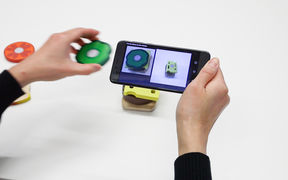Artificial intelligence passes on skills at the workplace

How can the knowledge and skills of an experienced employee be effortlessly passed on to new employees? Researchers at Aalto University have tackled this problem that many industrial companies have experienced by developing a toolchain based on artificial intelligence and computer vision. It would automatically create training materials such as instructional video and augmented reality (AR) based real-time assistance applications.
Many industrial companies have started to make video recordings of their employees’ executing assembly or maintenance processes. When given such a video, the toolchain can automatically extract workflow information, including the sequence of work steps and the operations in each step. The employees can review the workflow before it gets converted into an instructional video or AR application.
‘We estimate that this tool will make it possible to save 7-10 times the amount of time that it would take if employees had to label the video and create an AR-based assembly or maintenance assistance application manually. An experienced employee only has to check that the instructions created by the system are correct’, says the head of the research, Yu Xiao, professor of electrical engineering at Aalto University.
The developers’ goal is for the AR-based assistance system to make it possible for even a beginner to take control of a task at work without feeling any stress about possible mistakes. The system can tell if the employee is about to make a mistake and shows the correct workflow.
See the AI-driven assistant for final assembly and maintanance prototype demo video:
Saving time and money in the training of employees
The tool has been developed over the last year and a half with funding from Business Finland for the commercialisation of the research, and companies will soon begin piloting it. Taking part in the steering group of the project are three mechanical engineering companies that have drawn attention to the needs of users.
‘The use of videos in employee instruction is constantly on the increase, so we are interested in the possibility of automating the production of instructional videos. With this kind of technology, an expert could produce instructions while working in an authentic situation’, says Sanni Siltanen,
Expert, Innovative Maintanance Methods at KONE.
Tuula Ruokonen, Director of Digital Service Solutions at Valmet, feels that the system has excellent possibilities for the training of new employees.‘Our equipment can have thousands of different parts, and producing instructional videos and manuals for them is time-consuming and expensive’, Ruokonen says.
In addition to piloting, the researchers hope to continue the development of the tool.
’In the next phase, we plan to add a smart glove to the system which can record fine-grained hand movements, measure forces, and give immediate sensory feedback in the use of vibration, for example. In addition, we are working on a wearable augmented reality application that would further improve the data collection and workflow documentation’, Yu Xiao says.
The Cognitive Engine for Assembly and Maintenance Automation (CEAMA) project (ceama.aalto.fi) has included the utilisation of skills in deep learning, computer vision, augmented and virtual reality, smart textiles, as well as usability design. The project, which began in August 2018, has received New Business from Research Ideas funding from Business Finland.
More information
Read more news

Research Council of Finland establishes a Center of Excellence in Quantum Materials
The Centre, called QMAT, creates new materials to power the quantum technology of coming decades.
Major funding powers development of next-generation machine technology aimed at productivity leap in export sectors
The BEST research project is developing new types of sealing, bearing, and damping technology.
The TAIMI project builds an equal working life – a six-year consortium project seeks solutions to recruitment and skill challenges
Artificial intelligence (AI) is changing skill requirements, the population is aging, and the labor shortage is deepening. Meanwhile, the potential of international experts often remains unused in Finland. These challenges in working life are addressed by the six-year TAIMI project funded by the Strategic Research Council, and implemented by a broad consortium.






